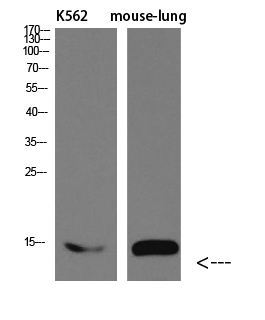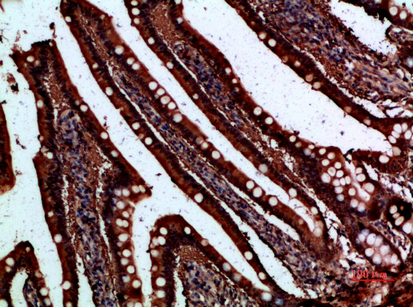I-FABP Polyclonal Antibody
- Catalog No.:YT5874
- Applications:WB;IHC;IF;ELISA
- Reactivity:Human;Mouse;Rat
- Target:
- I-FABP
- Fields:
- >>PPAR signaling pathway;>>Fat digestion and absorption
- Gene Name:
- FABP2 FABPI
- Protein Name:
- Fatty acid-binding protein, intestinal (Fatty acid-binding protein 2) (Intestinal-type fatty acid-binding protein) (I-FABP)
- Human Gene Id:
- 2169
- Human Swiss Prot No:
- P12104
- Mouse Gene Id:
- 14079
- Mouse Swiss Prot No:
- P55050
- Rat Swiss Prot No:
- P02693
- Immunogen:
- Synthetic peptide from human protein at AA range: 90-132
- Specificity:
- The antibody detects endogenous I-FABP
- Formulation:
- Liquid in PBS containing 50% glycerol, 0.5% BSA and 0.02% sodium azide.
- Source:
- Polyclonal, Rabbit,IgG
- Dilution:
- WB 1:500-2000,IHC 1:500-200, ELISA 1:10000-20000. IF 1:50-200
- Purification:
- The antibody was affinity-purified from rabbit antiserum by affinity-chromatography using epitope-specific immunogen.
- Concentration:
- 1 mg/ml
- Storage Stability:
- -15°C to -25°C/1 year(Do not lower than -25°C)
- Other Name:
- Fatty acid-binding protein, intestinal (Fatty acid-binding protein 2;Intestinal-type fatty acid-binding protein;I-FABP)
- Observed Band(KD):
- 15kD
- Background:
- The intracellular fatty acid-binding proteins (FABPs) belong to a multigene family with nearly twenty identified members. FABPs are divided into at least three distinct types, namely the hepatic-, intestinal- and cardiac-type. They form 14-15 kDa proteins and are thought to participate in the uptake, intracellular metabolism and/or transport of long-chain fatty acids. They may also be responsible in the modulation of cell growth and proliferation. Intestinal fatty acid-binding protein 2 gene contains four exons and is an abundant cytosolic protein in small intestine epithelial cells. This gene has a polymorphism at codon 54 that identified an alanine-encoding allele and a threonine-encoding allele. Thr-54 protein is associated with increased fat oxidation and insulin resistance. [provided by RefSeq, Jul 2008],
- Function:
- domain:Forms a beta-barrel structure that accommodates the hydrophobic ligand in its interior.,function:FABP are thought to play a role in the intracellular transport of long-chain fatty acids and their acyl-CoA esters. FABP2 is probably involved in triglyceride-rich lipoprotein synthesis. Binds saturated long-chain fatty acids with a high affinity, but binds with a lower affinity to unsaturated long-chain fatty acids. FABP2 may also help maintain energy homeostasis by functioning as a lipid sensor.,induction:By EGF.,similarity:Belongs to the calycin superfamily. Fatty-acid binding protein (FABP) family.,tissue specificity:Expressed in the small intestine and at much lower levels in the large intestine. Highest expression levels in the jejunum.,
- Subcellular Location:
- Cytoplasm.
- Expression:
- Expressed in the small intestine and at much lower levels in the large intestine. Highest expression levels in the jejunum.
- June 19-2018
- WESTERN IMMUNOBLOTTING PROTOCOL
- June 19-2018
- IMMUNOHISTOCHEMISTRY-PARAFFIN PROTOCOL
- June 19-2018
- IMMUNOFLUORESCENCE PROTOCOL
- September 08-2020
- FLOW-CYTOMEYRT-PROTOCOL
- May 20-2022
- Cell-Based ELISA│解您多样本WB检测之困扰
- July 13-2018
- CELL-BASED-ELISA-PROTOCOL-FOR-ACETYL-PROTEIN
- July 13-2018
- CELL-BASED-ELISA-PROTOCOL-FOR-PHOSPHO-PROTEIN
- July 13-2018
- Antibody-FAQs
- Products Images

- Western blot analysis of mouse-brain mouse-spinal-cord lysate, antibody was diluted at 2000. Secondary antibody(catalog#:RS0002) was diluted at 1:20000

- Immunohistochemical analysis of paraffin-embedded human-small-intestine, antibody was diluted at 1:200



